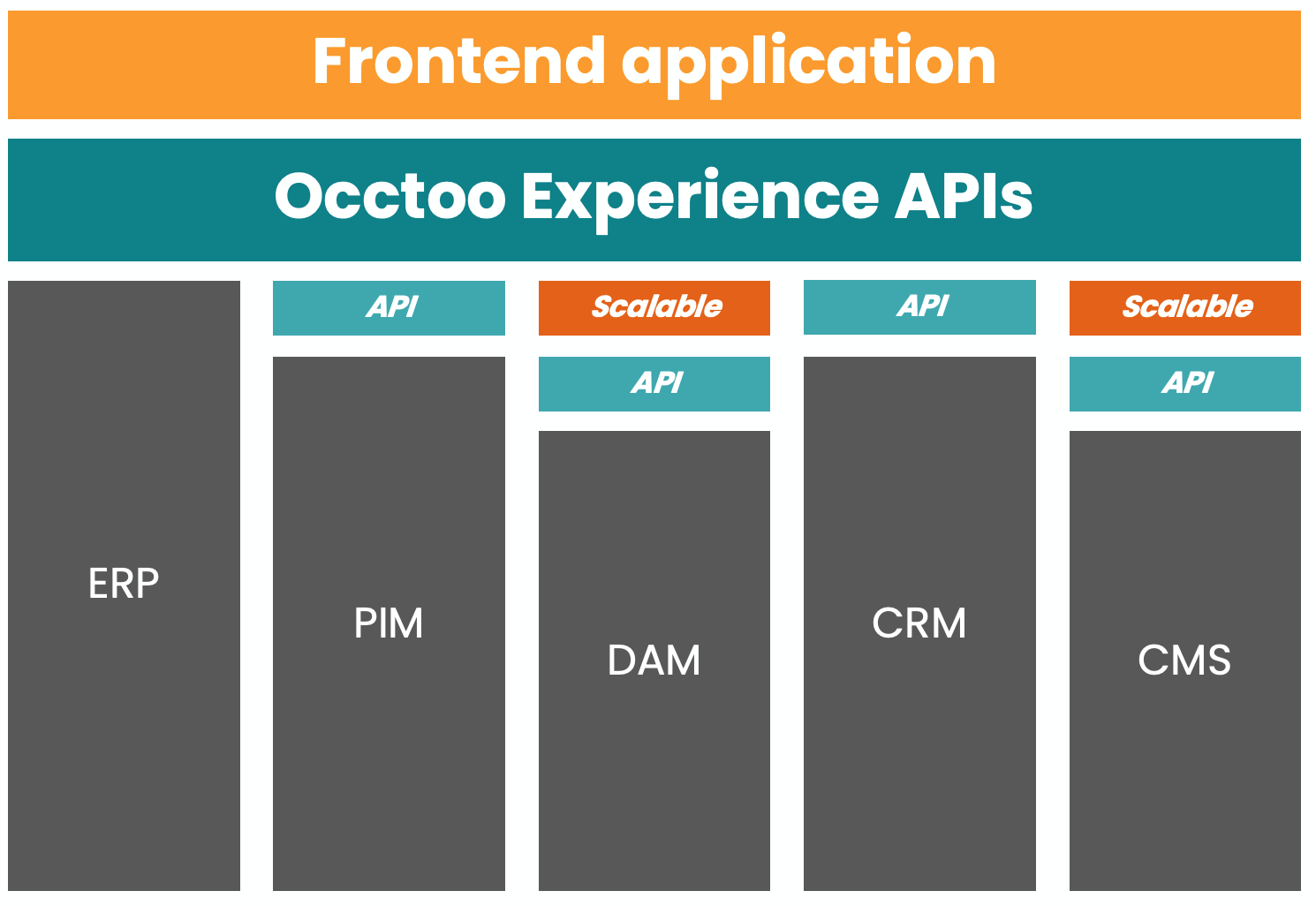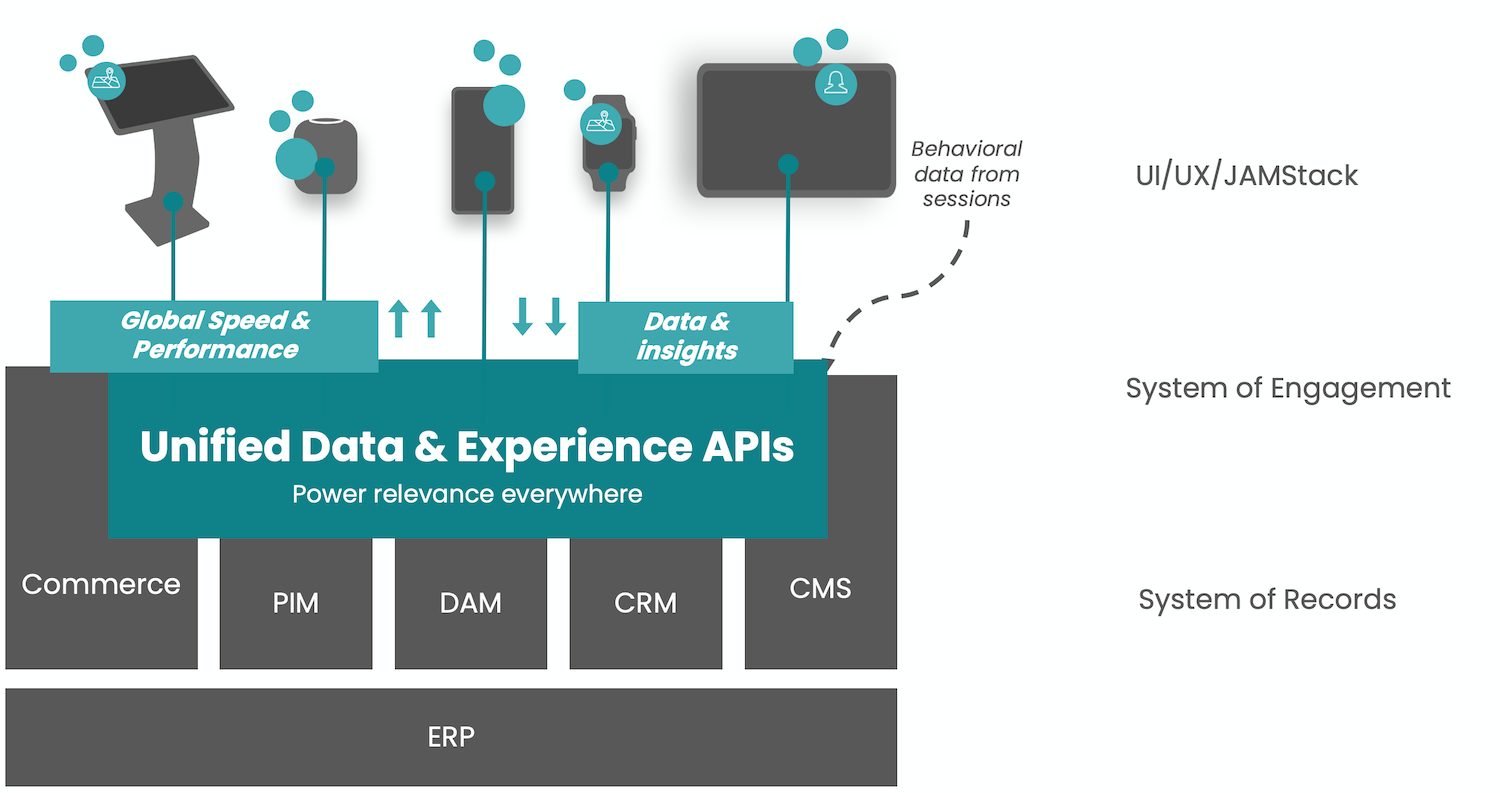With multiple customer touch-points and a reduction in brand loyalty, competing on price and product alone is no longer enough to position your business at the top.
In this blog, we explain what Composable architecture is, what it means to add it to your tech stack, and how and why companies are choosing this approach to implement a truly digital-first structure and launch new experience applications at record speed!Firstly, what is Composable architecture?
To build your tech stack with a Composable architecture you create an ecosystem of individual systems sharing their data via APIs. It could also refer to the architecture of a platform with small de-coupled, inter-dependent services communicating via events and API’s, also referred to as micro-services.
This modular setup enables a business to rearrange and reorient as needed depending on external or internal factors like a shift in customer values or sudden change in supply chain or materials.
How does a Composable architecture differ from the status quo?
Typically, organisations invest in technology to store and maintain specific single domain data (CRM, PIM, CMS, etc). These systems tend to be built on old legacy technology. This leads to data being locked into silos within systems of records.
This fragmented data landscape makes it increasingly difficult for companies to deliver an outstanding and unified customer experience at the front-end.
In this set-up, the creation of new innovations and experiences means constantly building everything from the ground up. It's time-consuming and often very costly. Furthermore, your digital teams and marketers are cornered and cannot innovate nor adapt to changed customer behaviours at the speed needed.
What does the new Composable state look like?
In the new Composable enterprise architecture state, the tech stack is built on cloud services and capabilities, which can be well described with the MACH definition, focusing on scalability and APIs.
- Microservices: Individual pieces of business functionality that are independently developed, deployed, and managed.
- API first: Functionality is exposed through an API.
- Cloud-native: SaaS that leverages the cloud, beyond storage and hosting, including elastic scaling and automatically updating.
- Headless: Front-end presentation is decoupled from back-end logic and channel, programming language, and is framework agnostic.
A Composable architecture combines your data through APIs and empowers your front-end developers to build applications with interchangeable blocks.
Why should you choose a Composable architecture?
The best way to secure long-term sustainability in today’s climate is to change thinking and embrace a digital-first approach: with contextual relevance and customer experience at the forefront of your campaigns.
Going composable is the path forward for companies who want to move fast and become agile, but the main challenge with a Composable is that data is scattered everywhere, but this is where Occtoo comes in to save the day!
The one thing everyone's missing when switching to Composable Architecture
Implement a fast and easy Composable architecture using Occtoo
Occtoo is a key component in a Composable architecture to provide a unified data layer sitting on top of your system of records. You then only need one interface to fuel the data from to your frontend layer, making it a seamless experience for your customers in the frontend.
You can see Occtoo's documentation here.

The main job of your system of records is to store and maintain all your single domain-specific data. The job of a System of Engagement (Occtoo) is to unify and activate your data bringing it to life in front of your customers using real-time APIs. With Occtoo you don't need to rip and replace system of records that is built on legacy technology. Occtoo just sits on top of these systems, unifying all data and transforms it into light weight and easy consumable data through real-time APIs. These previous investments becomes even more valuable because the data is easier for your digital teams to actually use.
Your digital teams can move from idea to implementation at record speed, because less time is spent on integration!

Occtoo is the missing piece of your unified experience stack, enabling speed in your “idea-to-deployment” process and without the hassle of ripping and replacing your existing technology stack.
Today, every company needs to be agile, and quick adaption is vital. The technology to support that is best-of-breed, Headless, and API-first. But the problem with this approach is that you get data scattered in many different systems, losing the ability to combine different kinds of data into contextually relevant experiences for the customers. Occtoo is the solution to solving this. It is a game-changer in the CX space, ensuring companies can become fast-moving and agile using modern technology without doing any trade-off in the end customer experience, says tech pioneer Moritz Zimmermann
Further reading: How to go Composable without replacing your current tech stack.
The benefits of using Occtoo in your Composable Architecture
- Easily connect all data, content and APIs: By using Occtoo you easily connect all data, content and APIs from all your systems into one low-code user interface so you don't need to spend a lot of time and budget on integrations.
- Free up time for your back-end developers: With Occtoo layered over your Composable stack, your front-end developers no longer need to rely on your back-end for lengthy and complicated integrations.
- Adaptability: You have instant access to all data and can re-use and re-purpose the data for every new innovation, application and channel. Innovate at with speed and at scale as the world changes.
- Leverage existing technologies: Use your existing technology, no need to rip and replace, and deliver unified data to the front-end with Occtoo.
About Occtoo
Occtoo is an Experience Data Platform that fast forwards how digital officers, marketers and developers create relevant customer experiences everywhere.
Unify all your experience data (transactional data, product data, customer data, content etc) with ease and access it from one single place. Make unique combinations of customer, context and content data and create an Experience API with a click to make the data available in real-time in any frontend, channel or device.
